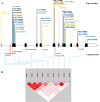Deep exon resequencing of DLGAP2 as a candidate gene of autism spectrum disorders
- PMID: 23915500
- PMCID: PMC3751063
- DOI: 10.1186/2040-2392-4-26
Deep exon resequencing of DLGAP2 as a candidate gene of autism spectrum disorders
Abstract
Background: We recently reported a terminal deletion of approximately 2.4 Mb at chromosome 8p23.2-pter in a boy with autism. The deleted region contained the DLGAP2 gene that encodes the neuronal post-synaptic density protein, discs, large (Drosophila) homolog-associated protein 2. The study aimed to investigate whether DLGAP2 is genetically associated with autism spectrum disorders (ASD) in general.
Methods: We re-sequenced all the exons of DLGPA2 in 515 patients with ASD and 596 control subjects from Taiwan. We also conducted bioinformatic analysis and family study of variants identified in this study.
Results: We detected nine common single nucleotide polymorphisms (SNPs) and sixteen novel missense rare variants in this sample. We found that AA homozygotes of rs2906569 (minor allele G, alternate allele A) at intron 1 (P = 0.003) and CC homozygotes of rs2301963 (minor allele A, alternate allele C) at exon 3 (P = 0.0003) were significantly over-represented in the patient group compared to the controls. We also found no differences in the combined frequency of rare missense variants between the two groups. Some of these rare variants were predicted to have an impact on the function of DLGAP2 using informatics analysis, and the family study revealed most of the rare missense mutations in patients were inherited from their unaffected parents.
Conclusions: We detected some common and rare genetic variants of DLGAP2 that might have implication in the pathogenesis of ASD, but they alone may not be sufficient to lead to clinical phenotypes. We suggest that further genetic or environmental factors in affected patients may be present and determine the clinical manifestations.
Trial registration: ClinicalTrial.gov, NCT00494754.
Figures


Similar articles
-
Resequencing and Association Analysis of Six PSD-95-Related Genes as Possible Susceptibility Genes for Schizophrenia and Autism Spectrum Disorders.Sci Rep. 2016 Jun 7;6:27491. doi: 10.1038/srep27491. Sci Rep. 2016. PMID: 27271353 Free PMC article.
-
Role of the DLGAP2 gene encoding the SAP90/PSD-95-associated protein 2 in schizophrenia.PLoS One. 2014 Jan 8;9(1):e85373. doi: 10.1371/journal.pone.0085373. eCollection 2014. PLoS One. 2014. PMID: 24416398 Free PMC article.
-
Genetic analysis of GABRB3 as a candidate gene of autism spectrum disorders.Mol Autism. 2014 Jun 25;5:36. doi: 10.1186/2040-2392-5-36. eCollection 2014. Mol Autism. 2014. PMID: 24999380 Free PMC article.
-
Altered synaptic protein expression, aberrant spine morphology, and impaired spatial memory in Dlgap2 mutant mice, a genetic model of autism spectrum disorder.Cereb Cortex. 2023 Apr 4;33(8):4779-4793. doi: 10.1093/cercor/bhac379. Cereb Cortex. 2023. PMID: 36169576
-
The genetics of autism.Pediatrics. 2004 May;113(5):e472-86. doi: 10.1542/peds.113.5.e472. Pediatrics. 2004. PMID: 15121991 Review.
Cited by
-
Resequencing and Association Analysis of Six PSD-95-Related Genes as Possible Susceptibility Genes for Schizophrenia and Autism Spectrum Disorders.Sci Rep. 2016 Jun 7;6:27491. doi: 10.1038/srep27491. Sci Rep. 2016. PMID: 27271353 Free PMC article.
-
Deficits in executive functions among youths with autism spectrum disorders: an age-stratified analysis.Psychol Med. 2016 Jun;46(8):1625-38. doi: 10.1017/S0033291715002238. Epub 2016 Mar 21. Psychol Med. 2016. PMID: 26997535 Free PMC article.
-
DNA methylation biomarkers of intellectual/developmental disability across the lifespan.J Neurodev Disord. 2025 Feb 19;17(1):10. doi: 10.1186/s11689-025-09598-5. J Neurodev Disord. 2025. PMID: 39972408 Free PMC article. Review.
-
Genetic variability in scaffolding proteins and risk for schizophrenia and autism-spectrum disorders: a systematic review.J Psychiatry Neurosci. 2018 Jul;43(4):223-244. doi: 10.1503/jpn.170066. J Psychiatry Neurosci. 2018. PMID: 29947605 Free PMC article.
-
Defective synaptic connectivity and axonal neuropathology in a human iPSC-based model of familial Parkinson's disease.Proc Natl Acad Sci U S A. 2017 May 2;114(18):E3679-E3688. doi: 10.1073/pnas.1617259114. Epub 2017 Apr 17. Proc Natl Acad Sci U S A. 2017. PMID: 28416701 Free PMC article.
References
-
- Prevalence of autism spectrum disorders - Autism and Developmental Disabilities Monitoring Network, 14 sites, United States, 2008. MMWR Surveill Summ. 2012;61(3):1–19. - PubMed
Associated data
LinkOut - more resources
Full Text Sources
Other Literature Sources
Medical
Miscellaneous

